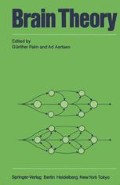Abstract
Point of departure are experimental data acquired by simultaneous recording of the activity of a number (2–16) of individual neurons during presentation of a sensory stimulus. The area under investigation is the auditory midbrain (Torus semicircularis) of the immobilized grassfrog (Rana temporaria L.). The sensory stimuli are both artificial (noise, tones and clicks) and natural sounds (vocalizations and environmental sounds). The goal of investigation is an insight into the neural representation of the sensory environment.
Access this chapter
Tax calculation will be finalised at checkout
Purchases are for personal use only
Preview
Unable to display preview. Download preview PDF.
References
Aertsen AMHJ, Johannesma PIM (1981a) The spectro-temporal receptive field. A functional characterization of auditory neurons. Biol Cybern 42:133–143
Aertsen AMHJ, Johannesma PIM (1981b) A comparison of the spectro-temporal sensitivity of auditory neurons to tonal and natural stimuli. Biol Cybern 42:145–156
Boogaard HFP van den, Johannesma PIM (1984) The Master Equation for Neural Interaction. IMA J Math Appl Med Biol 1:365–389
Boogaard HFP van den, Hesselmans GHFM, Johannesma PIM (1985) Transformation of point processes, correlation functions and system identification. Submitted
Braitenberg V (1977) Cell assemblies in the cerebral cortex. In: Hein R, Palm G (eds) Theoretical approaches to complex systems. Lecture notes in biomathematics, vol 21. Springer, Berlin Heidelberg New York, pp 171–188
Caianiello ER (1961) Outline of a theory of thought processes and thinking machines. J Theor Biol 1:209
Eggermont JJ, Aertsen AMHJ, Johannesma PIM (1983a) Quantitative characterisation procedure for auditory neurons based on the spectro-temporal receptive field. Hearing Res 10:167–190
Eggermont JJ, Epping WJM, Aertsen AMHJ (1983b) Stimulus dependent neural correlations in the auditory midbrain of the grassfrog (Rana temporaria L.). Biol Cybern 47:103–117
Eggermont JJ, Johannesma PIM, Aertsen AMHJ (1983c) Reverse correlation methods in auditory research. Q Rev Biophys 16:341–414
Epping W, Boogaard H van den, Aertsen A, Eggermont J, Johannesma P (1984) The neurochrome: an identity preserving representation of activity patterns from neural population. Biol Cybern 50:235–240
Gerstein GL (1970) Functional association of neurons: detection and interpretation. In: Schmitt FO, Quarton GC, Melnechuk T, Adelman G (eds) The neurosciences: 2nd Study Program. Rockefeller Univ Press, New York, pp 648–661
Gerstein GL, Michalski A (1981) Firing synchrony in a neural group: Putative sensory code. In: Székely G, Lâbos E, Damjanovich S (eds) Neural communication and control. Adv Physiol Sci vol 30. Pergamon Press, Akad Kiado, Budapest, pp 93–102
Guckenheimer J, Holmes P (1983) Nonlinear oscillations, dynamical systems and bifurcations of vector fields. Springer, Berlin Heidelberg New York
Hebb DO (1949) The organization of behavior. A neuropsychological theory. Wiley, New York; Chapman and Hall, London
Johannesma PIM (1972) The pre-response stimulus ensemble of neurons in the cochlear nucleus. In: Cardozo BL (ed) Proc IPO Symp Hearing Theory, Eindhoven
Johannesma PIM (1980) Functional identification of auditory neurons based on stimulus-event correlations. In: Brink G van den, Bilsen FA (eds) Psychophysical, physiological and behavioural studies in hearing. Delft Univ Press, pp 77–84
Johannesma PIM (1981) Neural representation of sensory stimuli and sensory interpretation of neural activity. Neural communication and control. Adv Physiol Sci 30:103–125
Johannesma PIM, Aertsen AMHJ (1982) Statistical and dimensional analysis of the neural representation of the acoustic biotope of the frog. J Med Syst 6(4):399–421
Johannesma PIM, Boogaard HFP van den (1985) Stochastic formulation of neural interaction. Acta Math Appl 4:201–224
Johannesma P, Eggermont J (1983) Receptive fields of auditory neurons in the midbrain of the frog as functional elements of acoustic communication. In: Ewert JP, Capranica RR, Ingle DJ (eds) Advances in vertebrate neuroethology. Plenum Publ, New York, pp 901–910
Palm G (1982) Neural assemblies. An alternative approach in artificial intelligence. Studies of brain function, vol VII. Springer, Berlin Heidelberg New York
Scheich H (1977) Central processing of complex sounds and feature analysis. Recognition of complex acoustic signals. In: Bullock TH (ed) Life Sci Res Rep, vol V. Springer, Berlin Heidelberg New York
Snyder DL (1975) Random point processes. Wiley, New York
Author information
Authors and Affiliations
Editor information
Editors and Affiliations
Rights and permissions
Copyright information
© 1986 Springer-Verlag Berlin Heidelberg
About this paper
Cite this paper
Johannesma, P., Aertsen, A., Van Den Boogaard, H., Eggermont, J., Epping, W. (1986). From Synchrony to Harmony: Ideas on the Function of Neural Assemblies and on the Interpretation of Neural Synchrony. In: Palm, G., Aertsen, A. (eds) Brain Theory. Springer, Berlin, Heidelberg. https://doi.org/10.1007/978-3-642-70911-1_4
Download citation
DOI: https://doi.org/10.1007/978-3-642-70911-1_4
Publisher Name: Springer, Berlin, Heidelberg
Print ISBN: 978-3-642-70913-5
Online ISBN: 978-3-642-70911-1
eBook Packages: Springer Book Archive

